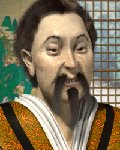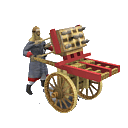The Koreans |
|||||||||||||||||||||||
| Profile | |||||||||||||||||||||||
|
|||||||||||||||||||||||
|
Korean Cities
Great Leaders
|
Background By 935 AD a general named Wang Kon established the Koryo dynasty, which ruled the Korean peninsula until 1392 AD. Koryo, from which the western word "Korea" is derived, was proclaimed as the successor to all of the conquered kingdoms and states. It was during the Koryo dynasty that Korea began to construct its own distinct cultural identity among the rest of the East-Asian civilizations. A bureaucratic system was created in order to replace the archaic tribal system that had previously governed the country, and civil service examinations were utilized as a means to select only the most capable officials and provincial magnates. The new bureaucratic force reaped by the civil service examinations held the applied precepts of Buddhism in disdain however, and with the assistance of Confucian-scholar General Yi Song-gye, the disgruntled officials seized power and established reforms that brought about the end of the Koryo dynasty, replacing the Buddhist-based system with Confucianism. The Yi dynasty named Hanyang (modern day Seoul) as the new capital of Korea, and operated from it for approximately 500 years until the Japanese annexation of Korea occurred in 1910. During the reign of the Koryo and Choson / Yi dynasties the advent of popular arts, as well as the introduction of Roman Catholicism in the 17th and 18th centuries, propelled Korea even closer to the modern state that exists today. A series of changes transpired that would impact virtually every sector of Korean society. Korean agriculture prospered as farming technology advanced. The cultivation of special crops such as tobacco and ginseng became possible, providing new and profitable trades products; which consequently, improved the standard of living for peasants drastically. The government began to mint coins and collect farm rent in cash. Markets were established across the country, creating a national trade network. Scholars switched focus from theory and speculation to matters of practical relevance, including the needs of society and state, while popular literature and artistic works also came into fashion. At the onset of World War II in 1941, Japan attempted to obliterate Korea as a nation. Hundreds of thousands of Koreans were drafted to fight and work for Japan during the war while the Japanese continued to commit numerous atrocities upon the Korean populace. The Korean provisional government organized the Korean Restoration Army to fight alongside Allied forces in China until August of 1945, when Japan surrendered. The end of Japanese rule caused great political confusion among the liberated Korean population. The U.S. and the U.S.S.R. supervised the permanent removal of Japanese forces and government from Korea, dividing it along the 38th parallel and sharing the task. The Soviet army however, was accompanied by a group of expatriated Korean Communists who were placed into key positions of power. The Soviet Union installed a Communist-controlled government in the North, which adopted the political structure of the Soviet Union. This new agency became the only lawful Korean government recognized by the U.S.S.R, essentially declaring war upon South Korea. South Korea was largely unprepared to resist a total invasion; aware of this, the U.S. Congress approved monetary and military aid to support South Korea. The resulting war lasted for approximately three years, but in that time over two-fifths of Korea’s industrial facilities, and one-third of its homes were destroyed. On July 27, 1953 an armistice was arranged establishing a cease-fire and a demilitarized zone between the two Korean factions, which still exists today. In Civilization III: Play the World, the Koreans are considered a Commercial and Scientific civilization, therefore, they start with Alphabet and Bronze Working, and have significant bonuses to scientific and trade-related activities. Unique Unit: The Hwacha The Hwach’a replaces the cannon as the siege weapon of choice for the Korean civilization in the Middle Ages. The Hwach’a is a more advanced artillery unit, capable of bombarding adjacent targets and unlike other siege weapons it is even able to kill them rather than simply reducing their health. A Korean city must have saltpeter to build a Hwach’a.
|
||||||||||||||||||||||

 Long before 3000 BC, the tribal immigrants of Manchuria and Siberia settled along the coasts and river valleys of the modern day Korean peninsula. These settlers were the original founders of what we know today as the Korean civilization. The immigrant tribes solidified into three rival kingdoms: Koguryo, Paekche, and Silla; and nearly simultaneously, the kingdoms achieved a complete centralization of power through wars of expansion, organized military systems, training institutions, and tribal aristocracies assembled within the capital cities. The maturation of monarchies in the kingdoms eventually eliminated the influence of the aristocracies however, and the balance of power waxed and waned as each kingdom endeavored to unite Korea under their exclusive rule.
Long before 3000 BC, the tribal immigrants of Manchuria and Siberia settled along the coasts and river valleys of the modern day Korean peninsula. These settlers were the original founders of what we know today as the Korean civilization. The immigrant tribes solidified into three rival kingdoms: Koguryo, Paekche, and Silla; and nearly simultaneously, the kingdoms achieved a complete centralization of power through wars of expansion, organized military systems, training institutions, and tribal aristocracies assembled within the capital cities. The maturation of monarchies in the kingdoms eventually eliminated the influence of the aristocracies however, and the balance of power waxed and waned as each kingdom endeavored to unite Korea under their exclusive rule. Some of the first anti-personnel devices created in Korea were comprised of small rockets attached to arrows, which flung spikes upon detonation. When it was discovered that several of these rockets could be launched from the same container, larger versions of these anti-personnel devices were created and utilized in battle. These larger anti-personnel devices were designed to be transported on wheeled vehicles such as a two-wheeled carts and wheelbarrows. The Hwach’a, which was invented in 1451, allowed a single man to transport approximately 100 rockets into battle, and was well suited to combat the invading Japanese Samurai who typically advanced on the Koreans in dense groups, presenting ideal targets for the Hwach’a operators.
Some of the first anti-personnel devices created in Korea were comprised of small rockets attached to arrows, which flung spikes upon detonation. When it was discovered that several of these rockets could be launched from the same container, larger versions of these anti-personnel devices were created and utilized in battle. These larger anti-personnel devices were designed to be transported on wheeled vehicles such as a two-wheeled carts and wheelbarrows. The Hwach’a, which was invented in 1451, allowed a single man to transport approximately 100 rockets into battle, and was well suited to combat the invading Japanese Samurai who typically advanced on the Koreans in dense groups, presenting ideal targets for the Hwach’a operators.